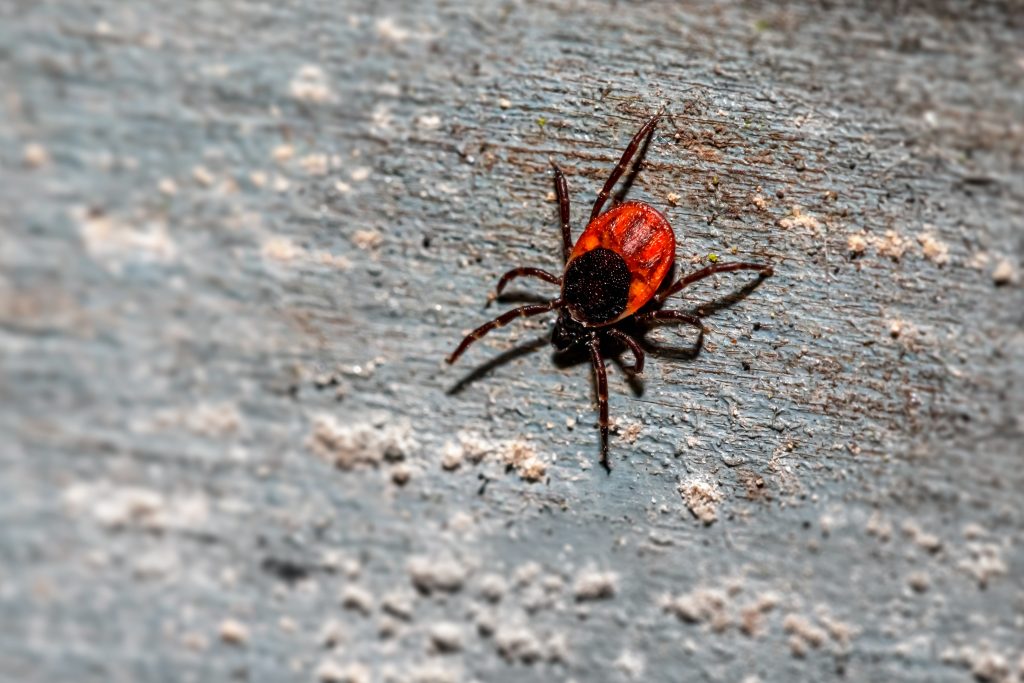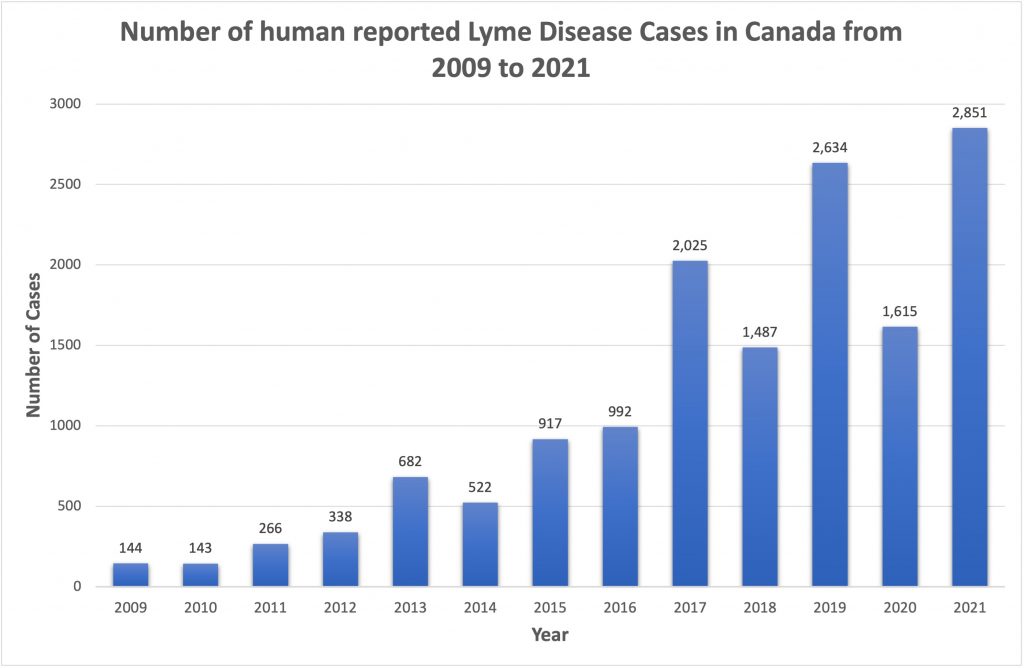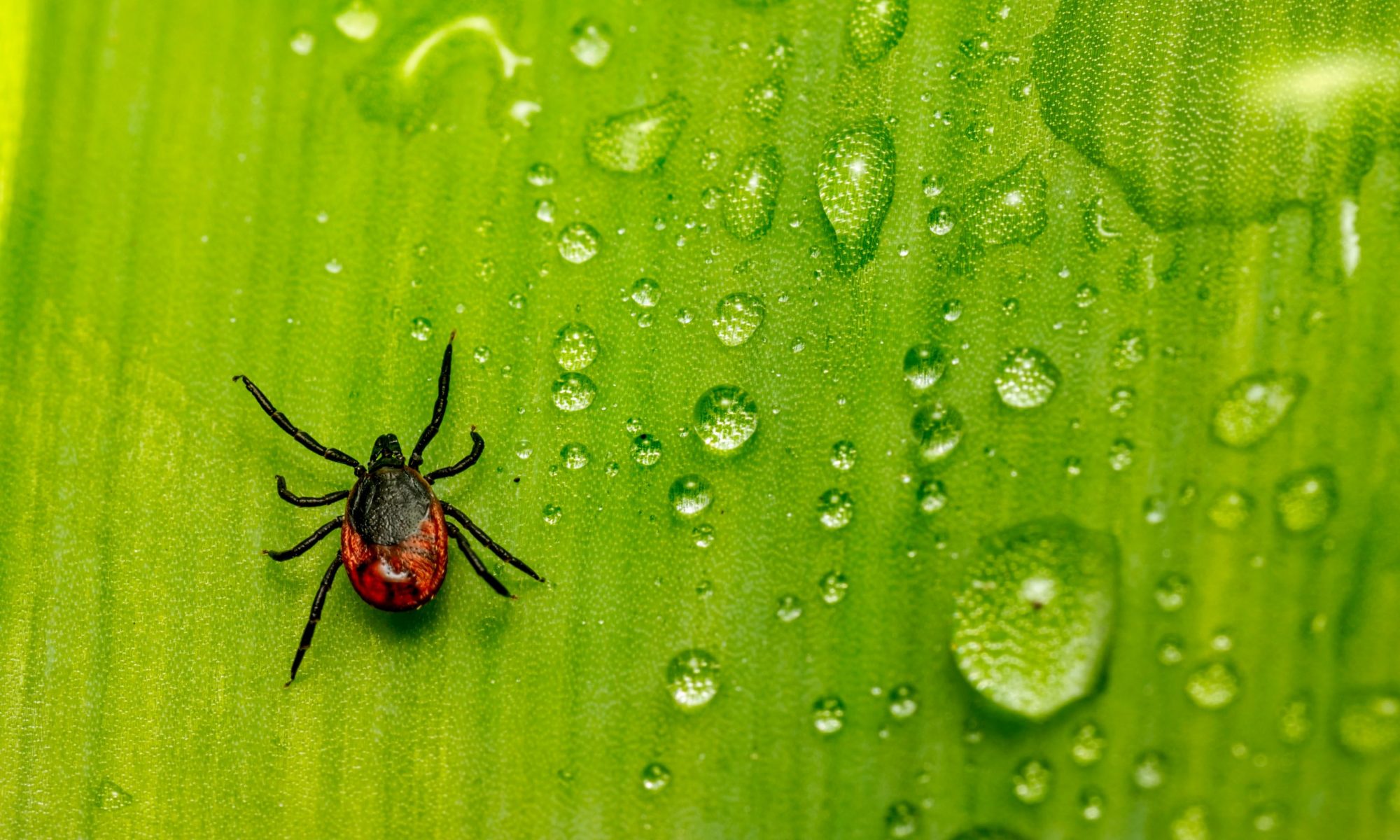Overview
Lyme disease is a disease caused by the bacterium Borrelia burgdorferi. It is transmitted to humans through the bite of infected black-legged ticks (Ixodes scapularis). Lyme disease has been found throughout Europe, Asia and North America and is one of the most common vector-borne diseases in North America affecting thousands of people per year (Cassidy, 2021). Over the past decade, reported cases of Lyme disease have been increasing in Canada, most notably in the provinces of Ontario, Quebec and Nova Scotia (Government of Canada, 2022). Using ESRI’s ArcGIS Pro software and the built-in spatial statistics program Presence-only Prediction (MaxEnt) which uses maximum entropy modelling, this study aims to determine the habitat suitability for Ixodes scapularis in Ontario and Quebec using present-day climatic and environmental data. This data will then be compared to another model with future climatic data (2041-2070) to predict tick migration and therefore the spatial areas for people to contract Lyme disease. Output maps will then be overlayed with park layer data to highlight areas at risk for the people of Ontario and Quebec. Understanding when and where cases are most likely to occur is key to the efficient targeting of limited public health resources to times and places it will have the most impact (Eisen et al, 2016).
Lyme Disease
Lyme disease is caused by the bacterium Borrelia burgdorferi. It is transmitted to humans through the bite of infected black-legged ticks (Ixodes scapularis) (CDC, 2021). Lyme disease is one of the most common vector-borne diseases in North America, affecting thousands of people per year (Cassidy, 2021). Typical symptoms include fever, headache, fatigue, and a characteristic skin rash called erythema migrans. If left untreated, infection can spread to joints, the heart, and the nervous system (CDC, 2021). Ticks become infected with Lyme disease bacteria by feeding on infected wild animals, such as birds and rodents. White-tailed deer are the key hosts of adult I.scapularis (Eisen et al., 2016). Once infected, ticks can spread the bacteria to humans and pets (IPAC, n.d).
Most humans are infected through the bite of immature ticks (called nymphs) that are approximately the size of a poppy seed, however, adult ticks can also spread Lyme disease (IPAC, n.d).
Cases of Lyme disease have been reported in nearly all states in the U.S. and in large areas in Europe and Asia, but the most common areas are the Northeast, upper Midwest and northwestern states in the US (Hopkins Medicine, n.d). Other vectors of the Ixodid ticks have been found in Europe, Asia and the Pacific coast of the United States.
Ticks
Ixodid ticks have a 2-year, 3-stage life cycle: larvae (hatching in the early summer), nymphs (following spring), and adults (nymphs moult to become adults in autumn). The tick may become infected at any stage of its life cycle by feeding on a host that is infected with B. burgdorferi, such as a small white-footed mouse. The nymphal stage is when the tick is most likely to transmit the infection (Murray & Shapiro, 2010).

The species of deer ticks (Ixodes scapularis) that carry Lyme-causing bacteria are found in warm, forested areas in the Northern Hemisphere. Although Lyme disease is a year-round problem, April through October is considered tick season (Hopkins Medicine, n.d) as spring and early summer are when nymph ticks feed (IPAC, n.d). Adult ticks are a bigger threat in the fall.
The factors that have been noted to influence tick presence include temperature (they require warm temperatures consistently above freezing (4°C), high humidity, a number of potential hosts (such as white-tailed deer), vegetation (shrubs, forests, leaf litter, wood, piles, grass or herbs) and sandy soils.
Climate
Climate variation is strongly associated with tick presence because tick activity and survival are inhibited below minimum temperature thresholds (Eisen et al., 2016). Tick mortality is high at extremes of temperature (both at lower (0 °C) to subzero temperatures and temperatures as high as 32°C). Tick development is most likely at around 25°C (Eisen et al, 2016). Eisen et al. have cited studies that have found that the annual cumulative number of degree-days above 0°C to be a convenient measure of annual cumulative temperature relevant to the duration of the tick life cycle. Temperature affects the duration of the life cycle, which in turn influences the survival of I. scapularis populations (Eisen et al, 2016).
The northern limit of ticks’ ranges has previously been attributed to either too few days during the warm part of the year with temperatures exceeding thresholds that allow ticks to survive or conversely too cold temperatures in the winter that limit survival (Eisen et al., 2016).
Deer ticks usually die off in freezing temperatures, but warmer and wetter winters in Canada with climate change are now allowing ticks to establish habitats farther north (Cassidy, 2021). Thus, as the global climate warms and temperature and precipitation conditions become more favourable for ticks, ticks are likely to migrate northward (Eisen et al., 2016), which means even more people are at risk of contracting Lyme disease (Cassidy, 2021).
Within temperature thresholds for survival, tick survival rates are also positively related with humidity, as they require high humidity environments to rehydrate (Eisen et al., 2016).
Soils
I.scapularis presence has also been correlated with sandy soils and wooded vegetation, and in a study by Guerra et al. (2002) on the distribution and abundance of Ixodes scapularis in the northern US, they found that tick presence was positively associated with deciduous, dry to mesic forests and alfisol-type soils of sandy or loam-sand textures overlying sedimentary rock. Tick absence was associated with grasslands, conifer forests, wet to wet/mesic forests, acidic soils of low fertility and a clay soil texture, and Precambrian bedrock (Guerra et al., 2002).
Hosts – Deer
Larvae and nymphs of Ixodes scapularis feed readily on a wide range of hosts, including lizards, birds and rodents. Adult stage ticks are restricted to larger mammals. The most important hosts for adult Ixodes scapularis are the white-tailed deer (Odocoileus virginianus) (Eisen et al., 2016).

Studies have examined if Lyme disease is spatially associated with the areas of high densities of deer and deer with Ixodes scapularis and have found it to be spatially significant (Raizman et al., 2013). Other studies have found that reducing deer densities around human-inhabited areas reduced the risk of the tick-borne disease in humans (Kilpatrick et al., 2014). Thus, white-tailed deer have been found to be a fairly accurate sentinel for human Lyme disease (Raizman et al., 2013) and will therefore be included as an explanatory variable in the analysis.
From this research, I have categorized the conditions for tick presence as follows which will guide data collection for this study:
- Warm temperatures (consistently above freezing – above 4 degrees C)
- High humidity (moist)
- A number of potential hosts
- White-tailed deer
- Vegetation
- Forested areas
- shrubs
- forests
- leaf litter
- wood piles
- grass or herbs
- Sandy soil
Lyme Disease Spread, Risk and Cases
Lyme disease has increased both in incidence and geographic extent in the United States and Canada over the past two decades, and one of the underlying causes has been changes during the same period in the distribution and abundance of the primary vector for the disease, Ixodes scapularis (Eisen et al., 2016). Kotchi et al. (2021) have showed that the risk of Lyme disease expanded north in Canada as temperatures changed over the time period of 2000 to 2015, with the highest risk of Ixodes scapularis occurring in 2012 and the lowest in 2000 (Kotchi et al., 2021). Between 2000 and 2015, Kotchi et al. found that Lyme risk doubled in the province of Quebec and tripled in Manitoba (Cassidy, 2021). This study aims to extrapolate current data on ticks in Ontario and Quebec to a future time period beyond Kotchi et al.’s 2015 threshold.

As can be seen from this graph, the number of cases has risen steadily in Canada since 2009, with a sharper increase in 2017, 2019 and 2021. 2021 data is preliminary data provided by the Government of Canada (2022).
It is likely that the actual number of cases is higher than the number of cases reported because Lyme disease cases can often be difficult to diagnose, thus Lyme disease may be a bigger concern than we realize (Québec, n.d).
Geographic distribution
From the Government of Canada’s 2019 Lyme disease surveillance in Canada: Preliminary annual report, they break down that the majority of cases (94.8%) were reported from Ontario (1,168), Nova Scotia (830) and Quebec (500). In 2019, Ontario, Quebec and Nova Scotia reported an increase in Lyme diseases cases by more than 60% compared to 2018. For the purposes of this study and ease of representation, Ontario and Quebec will be the provinces of focus.
Parks
As mentioned previously, ticks favour moist, shaded environments; especially leafy wooded areas and overgrown grassy habitats (IPAC, n.d). Such environments are found in the outdoors in gardens, parks, forests or other natural areas where people may perform outdoor activities like gardening, walks in the forest, golf, hunting, fishing, and camping. The Government of Quebec (n.d) notes that ticks can “cling to you or your pet when you are in contact with plants in a garden, in landscaping, in the forest, in wooded areas and in tall grass.” Shapiro and Gerber (2000) have noted that people with greater occupational, recreational or residential exposure to either tick-infested woods or fields near woods (the preferred habitats of ticks) in areas of endemicity are at a greater risk of developing Lyme disease. Accordingly, I have mapped out the provincial parks in Ontario and Quebec to highlight spaces that pose the greatest threat to inhabitants.
